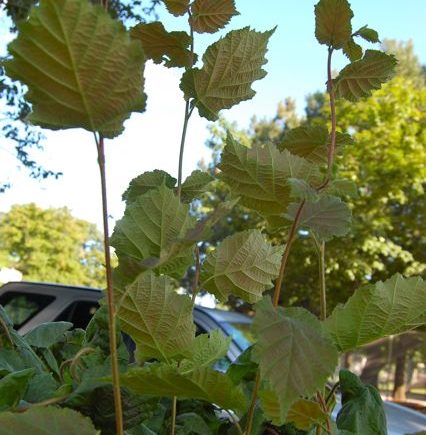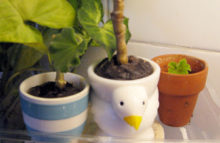With shade gardening, there’s a difference between plants that are shade lovers and shade tolerant.
Hostas, for example, are often considered shade lovers. Some do require shade to produce their best leaf colour. Yet, most hostas are simply tolerant of shade.
And here is my baby corkscrew hazel (Corylus avellana ‘Contorta’), which does best in full sun. However, with a bit of morning and afternoon sun in my front bed, it tolerates my shady garden. It gives me fewer spring catkins, but still makes the twisty stems that give this plant the common name, Devil’s Walkingstick.
[Oops, I stand corrected: sharp-eyed reader Nick points out that Devil’s walkingstick is the common name for Aralia spinosa. Corkscrew hazel is commonly named Harry Lauder’s Walking Stick. As far as I can gather, Sir Harold Lauder was a BMOC in the garden-design department, mid-19thC. Please feel free to correct me!]
HOWEVER (and you can see by the typeface that this is a big however), like many plants living in less-than-ideal conditions, corkscrew hazel does have a tendency to sport or revert back to its natural form, putting out straight stems rather than curly ones. The same can happen to plants with variegated foliage. Under stress, which is what less-than-ideal cultural situations create, they can gradually sport back to green.
You can’t tell the plant: cut it out! But you must cut it out yourself, pruning or pulling up the unwanted straight or green growth. Once sporting begins in a plant, it will likely recur. Besides marring the appearance you selected your plant for, the original form is usually more vigorous and can take over.





5 comments
My garden is mostly shade to part shade and I live in constant denial of this fact. Your post might have been written for me. Sometimes though, shade is a plus. It gets very hot in my part of Northern California, and I've found that planting some full sun plants like Helichrysum 'Limelight' in part shade controls both its growth and keeps the leaves a prettier shade of green than when planted in full sun. Although anything with flowers almost always looks scraggly in too much shade.
Susan, Denial is not just a river in Egypt, it's the constant state of many of us dry shade gardeners. You're right about the advantages of shade, too.
I'm not against shade per se; it's the exceptional dry shade that I've been gifted with (sand + Norway maples = constant strain on Pollyanna attitude) that's such a challenge.
My mother recently moved into a house with a heavily shaded, clay front yard with a full-sun, clay back yard with a steep grade. It's the worst of both worlds…
I've never heard of Corylus avelanna contorta referred to as Devil's Walking Stick. A few sites have it listed as "Harry Lauder's walking stick"; I've always called it Corkscrew Hazel. (http://hort.ifas.ufl.edu/shrubs/CORAVEA.PDF)
Aralia spinosa is more commonly known as Devil's Walking Stick; it's thorny and suckers like nuts…it's truly of the devil!
http://en.wikipedia.org/wiki/Aralia_spinosa
Hi Helen,
When I worked at East Of Eliza, we could not keep shade plants in stock. It was always difficult to find new and unusual plants. As you know 99.9% of gardens in the Beach are shady/sandy, however, we all deny that fact and continue to buy sun lovers. I have just bought a house in Owen Sound and once again it is shady, lots of trees as I back onto the Niagara Escarpment, however it is clay this time.
I want to tell you how much I am enjoying your blog.
Nick, You're absolutely right! I mis-spoke. I've updated the post to publicly admit my shame.
Deborah, sounds like you have a wonderful new canvas to paint — and no east-end Norway maples to muddy your palette. Happy gardening, and please come back to visit us anytime.